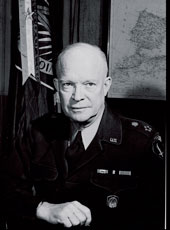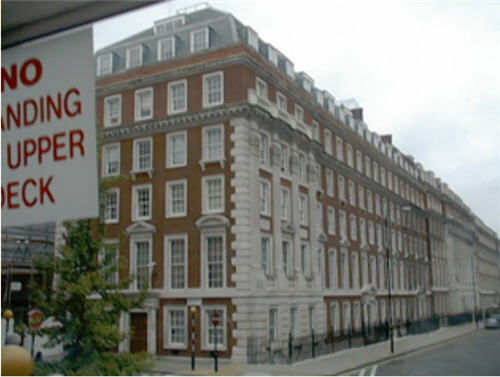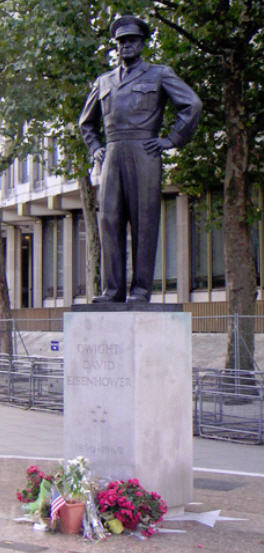Mac likes Ike
07 November 2016
Editor’s Note: Well, tomorrow is election day and with luck, all this unpleasantness will be wrapped up by midnight. Hahaha- just funning with you. The FBI apparently went through the 650,000 emails on the computer that senior aide Huma Abedin’s shared with her disgraced husband. I am relieved, of course, that a super-thorough review was conducted in the couple days that they had a warrant to look at the body text of all those messages. The Federal Government can be really thorough and highly motivated if there is enough at stake, you know? I am hoping that all the hoopla will be over soon. Never has an election had so many profoundly personal implications for all of us. But then, I suppose they all do. Even Ike had his challenges in what we now think of as a placid decade in the 1950s.
It wasn’t. Hear it from Mac at the Willow Bar.
-Vic
Mac likes Ike

(First Supreme Commander, Allied Forces Europe Dwight Eisenhower in his office in Paris, 1951. US Army photo.)
Monday is a fine day to stop at Willow after work in early October, and I had a lot of questions for Mac. He enjoys the $5 bar menu and a ginger ale or two, and he is hungrier now that he has engaged a personal fitness trainer. He is determined to get out and about more, now that his arm has healed, and though he drives to the restaurant from the Madison Assisted Living high-rise across the street, he is looking fit and feisty these days.
Mac favors an aloha shirt under his sport coat, sort of Hawaii business casual, and he was seated at the corner of the bar next to Old Jim, who is probably twenty-five years younger than Mac. Big Jim the burly bartender was talking about what the Steelers did yesterday. They won, 28-10, over the Browns, and for the record, he was feeling pretty expansive about it.
I slid onto the stool next to Mac and asked Jim for a glass of their cheapest white, which is our joke about the very good quality wine they pour at special happy hour prices. I noticed that Sabrina was looking good, all in black, which is Tracy O’Grady’s uniform for the bar staff. The wait staff in the dining room wear white shirts, which helps me sort out where I am after several stories and the accompanying beverages.
Peter patted me on the back as he went by to serve a table of smartly dressed women.
“So you never got around to telling me how you met President Eisenhower,” I said, opening my notebook next to my right hand and producing a pen.
“Well,” said Mac, “I met all the Five Star Generals or Flag Officers. Ike was special, though. He was President, but not of the United States. He had been recalled from his position as the chief executive of Columbia University to become the first Supreme Commander of Allied Forces Europe, the new NATO command in Paris.”
“There wasn’t an issue with him being recalled from civilian life?” I asked, making a note.
“No. Five-star officers were never considered to have left active duty. They retained military aides as long as they lived, as Admiral Nimitz did. Omar Bradley was the last of them alive. He died in 1981.”
“Was there an issue with Eisenhower being on active duty when he was elected President?” I asked. It had never occurred to me that there was an issue in that regard.
“No, Ike resigned his commission to serve as President. JFK recalled him to “active” duty when he took office o replace him, with a date of rank restored to the day he resigned.”
“Far out,” I said. “So what was the reason for your visit? It was in Paris?”
Mac nodded. “Ike arrived in Paris on New Year’s Day, 1951, and set up shop with his Planning Group at the Hotel Astoria. It was a nice location in the 8th Arrondissement, near the embassy and the Champs-Elysees and the Opera. Ike had a strange long office, with his desk in the middle. When we were shown in, he got up and walked toward us. He stuck out his hand and said “Eisenhower,” which was a bit surreal.”
“I imagine. He might have been the most famous American alive at that moment.”
“Indeed he was, and that is why they wanted him to be the first NATO Military Commander. There were a lot of details to be worked out, but with the Berlin Airlift just concluded the year before, the new battle lines of the Cold War were in place.”
“From Stettin in the Baltic to Trieste in the Adriatic an “iron curtain” has descended across the Continent,” I said, quoting Churchill’s words from the speech at Fulton, Missouri.
“And that is exactly why we were there to see him. We needed to get his permission to take a look behind the curtain. We could never do what we did without specific authorization.”
“And what was that?” I asked, thinking about the kinds of special reconnaissance programs that existed in the world before whizzing satellites.

(CINCNELM HQ, 7 North Audley Street, London, UK.)
“Well, that is a story all in itself. I got to London in 1950, and picked up my car at Southampton and got Billie settled in a flat not far from 20 Grosvenor Place, where the Navy had their headquarters.”
“I have been there a couple times,” I said. “The Fleet Ocean Surveillance Facility Europe was there before the consolidation with the Royal Navy’s facility at Northwood. We used the entrance on North Audley Street. You know the Navy moved out in 2009.”
“Pity. We had the building for a dollar-a-year lease that dated from 1942 when Admiral Stark moved in to establish COMNAVEUR. Ike briefly had his headquarters there before D-Day.”

(Ike’s Statue gazing at his former Headquarters building.)
“I have a picture of his statue in the square, placed so he is looking at the building.”
“Better than looking at that ugly Embassy building. The Brits used to call it “Rooseveltplatz,” because it was so ugly.” Big Jim refreshed my wine and Mac took a sip of ginger ale a little wistfully, since the Quacks had restricted his alcohol consumption due to his medication. “Here was the situation. After the war, the primary Navy mission in the occupied countries was to disarm the Germans and round up the war material. There was a huge Scientific and Technical mission to assess the state of the art. There were some astonishing things in Hitler’s bag of tricks. Hydrogen Peroxide-powered subs were just one of the breakthroughs that never made it into the war. Jet bombers. Ballistic missiles. All manner of things that we scooped up, along with the German engineers who had created them.”
“Werner Von Braun and his team were collected under Operation Paperclip and relocated to Huntsville, Alabama,” I said.
“Yes. And the Russians were vacuuming up Eastern Europe, too. All the harbors had been cleared of mines and debris and the geographic area of responsibility had been dramatically expanded. So, the command’s name became was changed to Commander in Chief, U.S. Naval Forces, Eastern Atlantic and Mediterranean. That was the command I reported to. Admiral Robert Carney became CINCNELM in December 1950.”
“So, what was it that Admiral Carney had to ask General Eisenhower’s permission to do?”
Mac smiled. “A thing called the Peacetime Aerial Reconnaissance Program.”
“PARPRO,” I said. “Flying around the periphery of the iron curtain to collect intelligence. That was around in my time, too.”
“Well, sometimes around it,” said Mac. “And sometimes right into it. But that is going to take another ginger ale. And what we told Ike helped mold his vision for what he was going to do as president.”
“Which was?”
“Open skies,” said Mac. “And in more ways than one.”
“They tried to change the name one year to PRCSO, or Peacetime Reconnaissance and Sensitive Operations. It was an unfortunate acronym, since it came out “prick-so.””
Mac smiled. “They also called it “SENSINT,” and you would be surprised at what went on.”
I wrote it down in capital letters. “Tell me more, Sir.” And so, he did.

(Navy PARPRO P2V2 Mariner. Oil painting.)
“In those days,” Mac said,”You have to understand that the military was filled with combat veterans who understood how to successfully approach a target. We knew that the electro-magnetic response to a perceived threat could be mapped and plotted. Sometimes we would run attack profiles on Russian installations to see what would happen, breaking off before we broke the sovereign territory. Although it was peacetime, we felt we needed to be ready for war at any moment, and the more we knew about where the Soviet radars were located would enable successful strikes. If we needed to do it. We flew specially-configured aircraft along the Soviet littorals, and those of their Warsaw Pact satellites to see what lit up and how their air defense command reacted. The dramatic developments around the successful penetration of the Manhattan Project made the interior of the Soviet Union a most important target, and there was talk of a growing “missile gap” in terms of capability between what would become the binary super powers. And that led to one of Ike’s biggest crises.”
“You mean the U-2 shoot down in 1960?”
Mac nodded. “Not a good morning for anyone after that. I was back in the States by then, but the fact that the Soviets had developed a surface to air missile capable of reaching the U-2 at altitude changed everything.”
“I read that Lee Harvey Oswald had been a radar operator assigned to Atsugi, Japan, where the missions originated. He would have been able to tell them just how high and fast the U-2s could go.”
“That would be an interesting aspect of his defection to the Soviet Union in October of 1959. I have some thoughts about all that, and the Crown Jewels and LBJ. We can talk about that sometime.”
I nodded, wondering if Mac knew something about one of the other great mysteries of the American Century. “Thankfully we had developed an on-orbit capability by then,” Mac said. “And no one ever was able to bag one of the CIA OXCARTs. Those and the SR-71 Air Force sisters are the most amazing airplanes that ever flew.”
Mac nodded in agreement and took a sip of ginger ale. “I am tired of the medication that makes me drink this stuff instead of beer,” he said. “But like Ike, sometimes you just have to do what you have to do.”
Copyright 2016 Vic Socotra
http://www.vicsocotra.com
